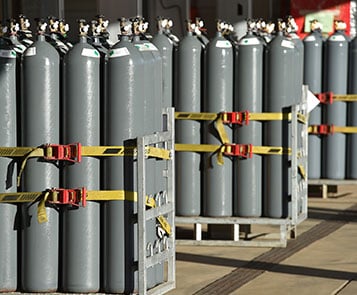Successful EHS Change Management Requires Outstanding Ambassadors
All too many environmental, health, and safety (EHS) professionals operate in a reactive mode in what is now a very fast-changing industry. Fortunately, as we've noted before, there are ways of leveraging traditional EHS skills to suit these changing times—and to apply EHS change management best practices for long-term success.
The environment for healthcare, life sciences, heavy industry, and other verticals demands forward-thinking and flexible leadership strategies. Yet, some managers and admins exist only to execute routine daily tasks and occasionally respond to emergencies. They fail to prepare for the long game, and influence the organization so it can change to not just survive in the long run, but actually thrive.
Nobody really likes changing (or even modifying) historically successful processes and thinking. This requires parting with what you know—in exchange for something you're not certain about, or know nothing of. We are deeply aware of what we might lose—and can hardly imagine what we may gain.
But change we must, or lose our competitive and operational excellence.
Outmoded EHS Management Paradigms
There are major ongoing EHS shifts, across the board—old management paradigms are becoming less relevant. Among the big-picture change drivers are:
- A growing demand from governmental bodies, workers, and the public for improved green practices
- The rise of environmental, social, and governance (ESG) principles in corporate reporting
- The increased adoption of electronic EHS solutions that extend data and applications throughout a facility and into the field
- The move of operations and safety managers into C-suite conversations
- A challenging overall business climate that requires reporting on key performance indicators (KPIs)
- Operational and regulatory needs for managers to adopt holistic, unified, and synched EHS management programs
These and other seismic shifts are demanding change management in our facilities, departments, teams, and overall organizations. The question is not when—but how (and how smoothly) we become agents of change management.
EHS Goals: Moving Targets
It’s the nature of the world to change. Old ways fail—think whale oil versus petroleum last century, and green energy versus burning fuels today. When one set of systems ends, we must turn to or invent a new one. Hopefully, we have fresh approaches available.
In recent years, I’ve seen the old EHS paradigm becoming sclerotic. The onslaught of COVID-19 accelerated this shift, making EHS managers key players in the C-suite, where they assisted directly to protect employees and the public.
Then there is the green movement at work: We're even seeing the acronyms in our titles change. Some of us are now EHSS or SSHE directors—the extra “S” signifying sustainability—with yet more functions to fulfill. So, for many organizations, the EHS world is evolving very quickly, and a successful pivot is a challenge.
Eliminate the EHS Blind Sides
To better understand how to adopt successful operational change management, we should look at some specific areas ambassadors must monitor and react to:
- Technology, particularly those cloud-based, electronic solutions that add data and sophistication to reinvent processes
- Public opinion is always fickle, and a challenge—but in an age of climate change and nonstop environmental disaster, consumers and citizens alike are demanding greener and more sustainable EHS approaches
- Human resources, particularly of the technical and certified variety, are always difficult to recruit—and the talent market is as competitive and unpredictable as I’ve seen it in 15 years in the field
- Legislation for the environment and public safety at the state, federal, and local levels, which is subject to frequently unpredictable updates, revisions, overrides, and so on
- Enforcement bodies, such as the Environmental Protection Agency (EPA) and the Occupational Health and Safety Administration (OSHA), which are constantly changing penalties and foci
It's difficult to juggle all these EHS balls at once. And many organizations are reacting to market or industry shifts slowly—or only when goaded by public or legal demands for safety or sustainability. This approach harms chances for competitive success (a green company tends to be more efficient and lean). This applies particularly in the private sector, where pressure for ESG provisions and sustainable principles adoption is immense.
Here, success demands adopting a proactive posture. This is true for the startups trying to innovate, as well as for established million-dollar enterprises. Even for large public companies, the green and environmental requirements come right from the shareholders. Thus, filling in any sustainability process gaps is essential—not a nice-to-have.
Change Management: Where People Count
Your organization likely comprises buildings, machinery, labs, equipment, intellectual property, IT systems, and people. But modern computers, techniques, protocols, and information can only do so much to make you an EHS success.
Ultimately, it’s the people, those who execute the business processes, who are the most essential. They are the EHS culture, and are the only ones who can change the culture. You need the best—the ambassadors of EHS change management. Skimping on talent—while paying top dollar for, say, the latest mobile systems with the best interfaces and reporting tools—is a recipe for EHS change failure.
Your team members—or external partners—are the make or break for handling change. They’ll make the difference in the effort to change successfully. Without their dedication, your organization may be left clinging to old methods and risking loss of your competitive or operational edge. To make this task more complex, getting the true “silver bullet EHS pro” (the special manager, administrator, or front-line person who never lets the organization lag) is even harder.
Profile of EHS Change Ambassadors
To help you, I’ve outlined below the most essential qualities for an EHS change master—one that will be an ambassador of change and excellence. Ambassadors should:
- Proactively move the organization’s direction. To effect appropriate, long-lasting change, there is no one rigid, single rule for every company, department, or team. Depending on the circumstance, organizational culture, and industry, an effective ambassador should apply the approach that is most impactful. They should get the big picture—but understand that sometimes small steps are needed to achieve this. That way, they can gradually and proactively take employees and departments to higher levels of EHS success.
- Have the proper training and education. Knowledge is power in EHS. To be effective, change ambassadors must:
- Know their functions and responsibilities
- Understand their industry—including its drivers and stress points
- Recognize legislative and organizational imperatives
- Have special training in best techniques and management practices
- Come with an in-depth understanding of EHS processes
- Inspire others to follow them
- Introduce fresh ideas into the organization. Sometimes a change ambassador can be groomed from the internal team member pool. But a homegrown change ambassador is almost always tempted to do the easy or quick thing—not necessarily the right or most efficient one. Often, burdened by a busy schedule or overarching operational responsibilities, an internal EHS professional will lean towards doing the minimum—and just reuse existing and inadequate protocols. That is why it’s worth thinking about securing an outsider for these tasks—a person with deep experience and savvy, but who will be new to the organization and see it and its challenges with a fresh eye.
EHSOne®: Change Management at Its Best
Every client needs its own special sauce for EHS success. To that end, Triumvirate Environmental fields its army of change ambassadors through its EHSOne® program. As your EHS business partner, this starts with deploying our best team members on-site
While at your facility, our team learns your culture and adapts it for success with the best and latest practices. The ambassadors innovate, thinking ahead about what is the client's next best move—they don’t just review and assent to what worked before.
We have a long EHS history that brings in fresh strategies for long-term success. And we are comprehensive: We manage high-level program planning and culture shifts—but also handle the most basic EHS requirements. No matter what the program, we demonstrate sensitivity to the future and the ability to course-correct. Talk to us today about how we can help you master change, with proper ambassadors.






